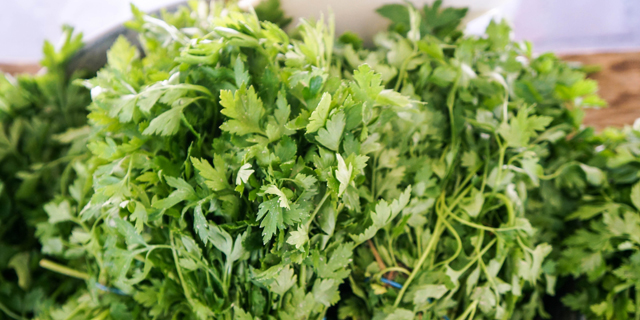We sprinkle parsley on all of our savory dishes because it’s delicious and transforms each plate into a work of art. But parsley isn’t just nice to look at; it’s good for you too! You may know this bright green herb, which can be both flat and curly, as salsa, parsley or, you guessed it, perejil! At 20 calories per cup, these little greens are rich in calcium and iron, vitamin K, and they provide you with more than your daily dose of vitamins A and C.
How do I pick the best parsley?
Perejil is a staple in every Latin kitchen, and every Latina knows that fresh is the best way to go. Look for bunches that are bright, with even coloring from the bottom of the stalks to the tip of the leaves. Stalks should look freshly cut and leaves should be lush and hearty. Avoid bunches with yellowing or browning leaves, wilting leaves and stalks or dried stems. The bunch should smell fresh. Look for slimy leaves and make sure you look at the heart (middle) of the bunch for any signs of decay. There are a lot of parsley bunches out there: only settle for the best.
Parsley is a great herb to have on hand and is easy to grow outside or in your kitchen window if you want to exercise your green thumb. Parsley grows best from seed planted in well-drained, moist soil with full sun and a bit of shade. The biggest task in cultivating it is keeping the soil moist, as it needs the constant water supply to grow and produce more leaves. Growing up to 1 1/2 feet in height, parsley can be harvested 2-3 months from planting. Cut stems off from the bottom of the plant and cut no more than a 1/3 at a time so the plant continues to grow.
A biennial, parsley can be grown all year round which means you could have your own supply of fresh perejil to toy around with through every savory and sweet season. Imagine that!
What can I make with parsley?
Parsley is known for its flavor and ability to enhance the flavors of savory dishes. Add chopped parsley to a quinoa salad, throw stems in a hearty goat stew or add it to your morning shake for a nutritional boost! The sky is the limit on how to use parsley since it is flavorful raw or cooked.
And storage? Store bought parsley should be washed and set aside on a towel to drain. Parsley may be a bit sandy and gritty so make sure you wash it well. Poke a ziplock bag with a toothpick ten times, with the holes evenly distributed. Transfer parsley to the ziplock and refrigerate until ready to use. Fresh parsley should be placed in a cup of water and transferred to the fridge, where the little perejil tree will stay vibrant and fresh up to a week.
Recipes to try include: Cayenne Parsley Spring Chicken, Green Spicy Potatoes, Grilled Gaucho Steak with Chimichurri, and Molho á Campanha.


![Making Mealtime Matter with La Familia: Easy Sofrito [Video]](https://thelatinkitchen.com/wp-content/uploads/2015/10/sofrito-shutterstock__0-500x383.jpg)
![Easy Latin Smoothies: Goji Berry Smoothie [Video]](https://thelatinkitchen.com/wp-content/uploads/2015/12/goji_berry-shutterstock_-500x383.jpg)
















![Fun and Fast Recipes: Fiesta Cabbage Salad [Video]](https://thelatinkitchen.com/wp-content/uploads/2015/11/fiesta_cabbage_slaw-shutterstock_-500x383.jpg)









